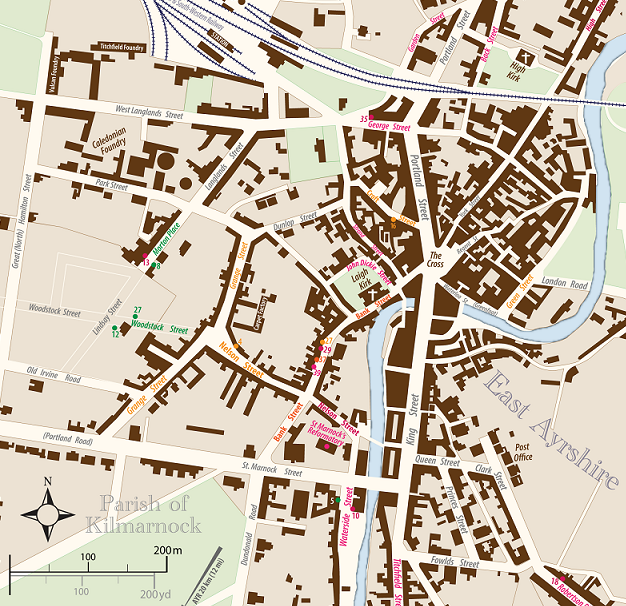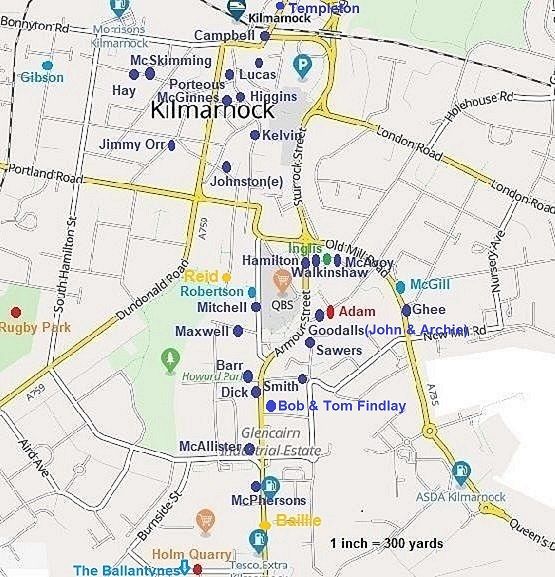The Killy Trail

Old Kilmarnock circa 1860
Kilmarnock F.C. is the second oldest club in Scotland, second only to Queen's Park. It was formed in 1869. In 1873 it was a founding club of the Scottish Cup but not of the Scottish League in 1890. It joined in 1895. Meanwhile in the the town it had been joined in 1875 by Winton F.C. that emerged from a cricket club until in 1877 Kilmarnock Cricket Club (KCC) formed its own football section and it merged with Winton to create the Kilmarnock Football and Cricket club, which, playing at the KCC ground, Quarry Holm, quickly became Kilmarnock Athletic. And the reason for this preamble is that, whilst Kilmarnock is today the Ayrshire town's major club, for the eight years of its existence Athletic was more successful and it was thus initially its players, who were to take Killy football into the wider World, albeit with two caveats. One is that that "World" was limited largely to South of the Border and the other is the major driver in the transfer was that perhaps its players came cheaper than from elsewhere. However, it does not change the fact that from two, largely cleared and flattened, working-class districts of the old town, now shopping centres and industrial units, in the decade from 1880 over twenty young men would with varying degrees of success take mainly the English shilling.
Yet Athletic can count only one Scottish cap, that awarded to goalkeeper, John Inglis, in 1884. Born in Riccarton on Kilmarnock's southern edge he would move into town and take the field with Athletic for six seasons from 1878, also win two Ayrshire Cups and reach the semi-final of the Scottish Cup in 1882, only to lose narrowly away to eventual winners, Queen's Park , Kilmarnock having been knocked out two rounds earlier. Moreover, the club would do it again in March 1883, this time losing to Vale of Leven on a replay, Kilmarnock losing in Round One. Indeed these narrow losses might even be seen with a subsequent friendly in Bolton at Great Lever as triggers to Athletics demise as, within a further two seasons, its team, the aging Inglis excepted, was essentially stripped.
It began in December 1883, although a couple of players also from that same part of the town, John Reid, who would go on to play for New South Wales, and Billy Baillie, may already have been tempted away by work to Australia. Athletic had just played a friendly against Preston North End and lost, having beaten Bolton's Gt. Lever two days earlier. Conversations were clearly had, resulting in three, perhaps four of Athletic's players signing for the latter - Goodall and Walkinshaw, a year apart in age, who lived two minutes walk round the corner from each other, and Lucas and, possibly Hay, again a year in age and just five minutes or so in distance apart.
Of the four John Goodall would be far and away the most successful. In a career as a forward at top-fight over the best part of fifteen years he would make well over four hundred appearances and win fourteen caps. The only problem is that they were for England for, whilst he had had Scottish parents, was almost entirely raised in Scotland with its football, he was born in England and under the then rules could only play for the Saxons; and did they lap him up. However, there would be perhaps another eight fine players of similar age to the Gt. Lever "three" or "four", for whom there would be developing interest. Next to go south in 1886 was Archie, John Goodall's younger brother and like him raised in Killy but this time born in Ireland so again denied Scottish representation. Then in 1887 "Kitey" McPherson went to Everton, at which point with the formation of Football League in 1888 things racked up to another level. At home Kilmarnock now had the local field more or less to itself. John Smith had joined before moving on to Newcastle as had Sandy Higgins Snr. before Derby. Moreover, James "Bummer" Campbell now joined the town club, whilst Bob McSkimming went directly to Stoke and Bobby Barr joined him there.
Then in 1889 three more were also on their way. Tom Porteous, another who was England-born but Scottish raised went to Sunderland, David Mitchell to Glasgow and Rangers and Frank McGinnis to Burslem, again in The Potteries. And in 1890 there were two more to come through, Billy Sawers and Jocky Johnston(e). Indeed, whilst the former would go to Blackburn, Johnston(e), probably as a result of the creation of the Scottish League would join Campbell at their hometown club. Indeed both would win international recognition with Killie. Furthermore 1891 would see other Scottish teams also recruiting. Kitey McPherson's younger brother, David, at just eighteen would be a second to go to Rangers, there winning one cap to his sibling's nine. That was as Douglas Dick went to Morton and before the English came in once more. In 1892 Robert Maxwell went to Darwen, Andrew Kelvin from Killie to Liverpool, in 1893 Tommy Ghee again to Darwen first, back to Kilmarnock and then Newcastle and last but not least in 1897 Sandy McAllister, the youngest of the crop, laso took the road to Wearside.

The Players - Internationals
Others - to Scotland, England and Beyond
Killy Soccer
And from Kilmarnock in particular there was to be something of a second wave of pioneering players, who rather then heading south moved west. In the 1920s football, "soccer", in the United States took fire and for the decade before The Depression burned brightly. It was to attract players from many sources but none more so than Scotland with at least six from the Ayrshire town. David Robertson, raised in the same tenements as his fore-runners, was to have two seasons at full-back at his hometown club before taking himself to New York, eight seasons at Brooklyn Wanderers and later life and death in Los Angeles. Charlie McGill, also a full-back, would be another to take himself off at twenty-two to five years in New England, a return to the Scottish game and seven more at Aberdeen but final years back across The Pond.
Alex Lorimer would also play for hometown Killy, albeit only once, and across the water would first head for Philadelphia. But he too found his place with almost a decade in New England, as would Bobby Walker, via a Paisley-birth but sixty-six Killie starts, and David Gibson for five seasons, that had been preceded by well over two hundred games at Rugby Park and would be followed by a return, albeit brief, to the Scottish game. And finally there is Jim Brown, a part of a football and rugby dynasty in four countries, Scotland, the USA, England and South Africa and over the best part of a century. But then, whilst he was born in town it was in hospital with the Lambie/Brown family/families in reality frae Troon.
And then there is Canada, where soccer had smouldered since the 1880s, from David Forsyth onwards, spreading as the country expanded westward, fuelled by successive generations of newly-arrived Scots until Canadians national teams toured in the 1920's, first to Australia in 1924 and to New Zealand in 1972. On the first a Killy boy was one of the players. On the second he was the Tour Manager.
Clubs Grounds
Kilmarnock F.C. (Wiki) Rugby Park
Back to SFHGHome page